After struggling at the start of the 2020-21 Bundesliga campaign with Borussia Dortmund, Jadon Sancho has really begun to rediscover his world-class form since the turn of the new year. Now 21 years old and with crucial goals and assists again beginning to flow at a phenomenal rate both domestically and in Europe, we analyse where Sancho ranks against some of world football’s recent greats at the same age.
Despite relatively poor form by his own usual high standards at the start of this campaign, Jadon Sancho has now turned the corner and is helping to drag an out-of-sorts Borussia Dortmund side back into both domestic and Champions League contention. With 12 goals and 13 assists through 31 matches across all competitions, the England international is again more than proving his worth in Germany with BVB.
Now into his fourth season with Borussia Dortmund, Sancho has developed into one of Europe’s most talented young stars. Since 31 Aug. 2017, no other player under the age of 21 across Europe’s top five leagues has been able to match Sancho’s direct goal involvement tally. Through 7,211 minutes of action for Dortmund in the Bundesliga, the 21-year-old has produced 79 goal involvements with 36 goals and 43 assists. That overall total beats out second-place PSG forward Kylian Mbappe at 74 and Chelsea-newcomer Kai Havertz at 47 who sits third. It also gives the tricky winger a rate of scoring or assisting once per 91 minutes — a phenomenal record for any wide midfielder across the top five European leagues, let alone one so young.
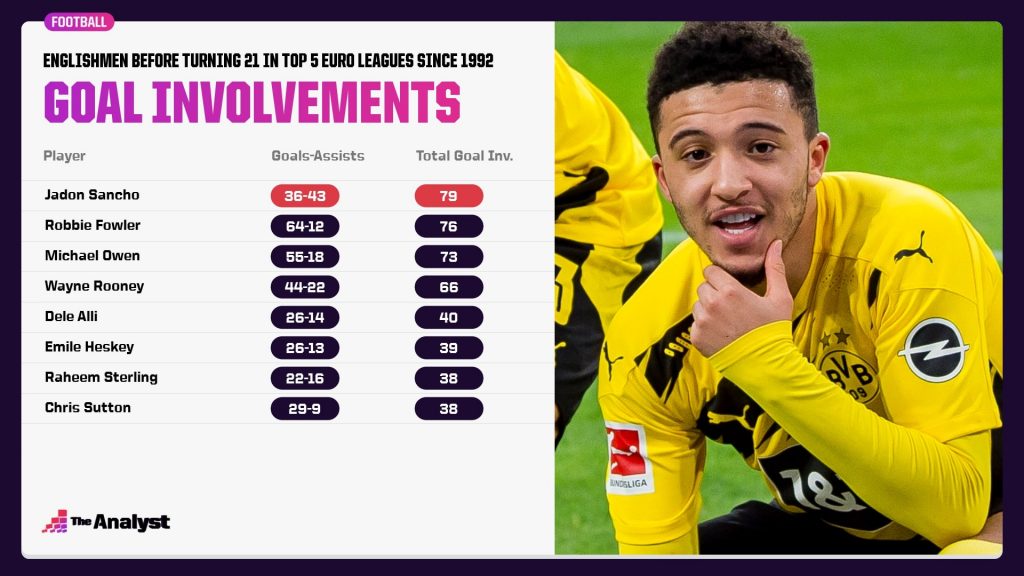
In a wider context, that same tally sees him top the table of goal involvements by English players before turning 21 within the top five European leagues since the inception of the Premier League in 1992.
Despite playing substantially more minutes than Sancho throughout their teen years, Robbie Fowler, Michael Owen and Wayne Rooney all have lesser records. In fact, looking at assists in particular, no player is even close to Sancho’s total, with Rooney ranking second to Sancho’s 43 with 22 of his own. Even in terms of goalscoring where you’d expect a winger to struggle against previous English strikers, the Dortmund youngster beats out Emile Heskey and Chris Sutton, who had 26 and 22 goals respectively before turning 21.
The accolades don’t stop there though. A strike from the penalty spot in late February against Arminia Bielefeld meant that Sancho overtook Chelsea’s Kai Havertz on the list of most goals by an under-21 player in Bundesliga history with 36. Granted, teammate Haaland may yet break that record by the end of the season given his recent form, but even so, that record speaks volumes of Sancho’s attacking quality since he joined Dortmund in the summer of 2017.
When you delve deeper into the statistics, it’s easy to see why his goalscoring has been so strong in Germany. Over his four seasons in the Bundesliga, the English winger has massively overproduced in terms of scoring, returning 35 goals from a non-penalty expected goals total of just 23.7. In fact, he’s one of only 11 players within the top five European leagues to have outperformed his xG total by more than 10 since his debut in October 2017.
He’s proven to be clinical in front of goal and over time has refined his shooting even further, ensuring he’s attempting efforts from a closer range. His pace gives him the opportunity to do that, as he often bursts and darts towards the back post behind the full-back or just outside the middle of the six-yard box to finish crosses or passes from the opposing wing.
In fact, only seven of his goals have come from behind the penalty spot in his short Bundesliga career to date, and, surprisingly, just one has come from outside the penalty area altogether. Considering his usual position out wide on either flank, his xG chart almost replicates that of most leading strikers throughout world football.
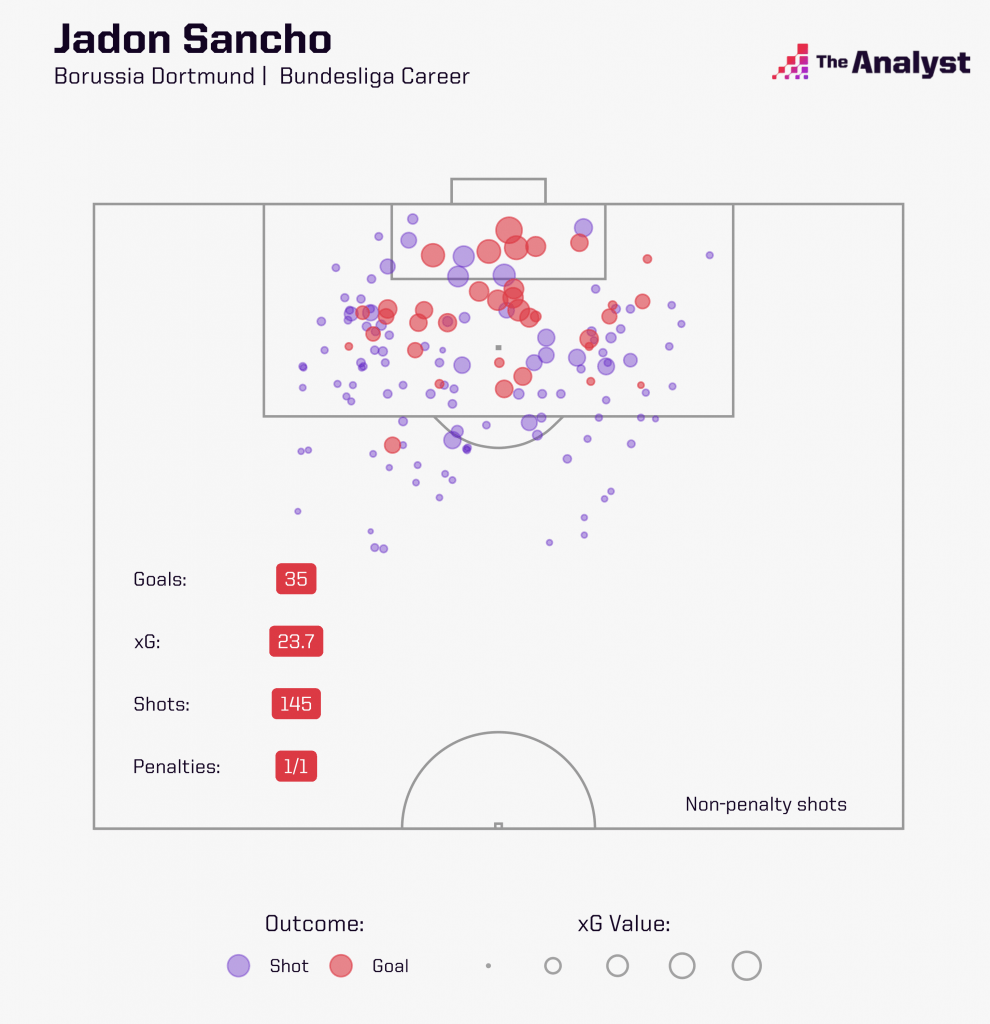
Despite attempting shots more frequently this season than any of his previous Bundesliga campaigns – once every 40 minutes on average – his goal return has fallen, with just five goals from 43 non-penalty shots in the Bundesliga.
He’s only nine shots off his tally in 2019-20 (52), but with 12 goals fewer it could be concluded that his shot selection hasn’t been as intelligent this campaign.
In 2019-20, his average xG per open-play shot was 0.20. This suggests that the average player would be expected to score on 20% of these shots, based on the positioning and scenarios in which Sancho found himself shooting. So far in 2020-21, this has reduced to nearly half (0.11), which is his worst ratio in a single league season. But his dip in form earlier in the season could be to blame for that, and a return to form should see his expected conversion rate steadily grow up to the end of the campaign.
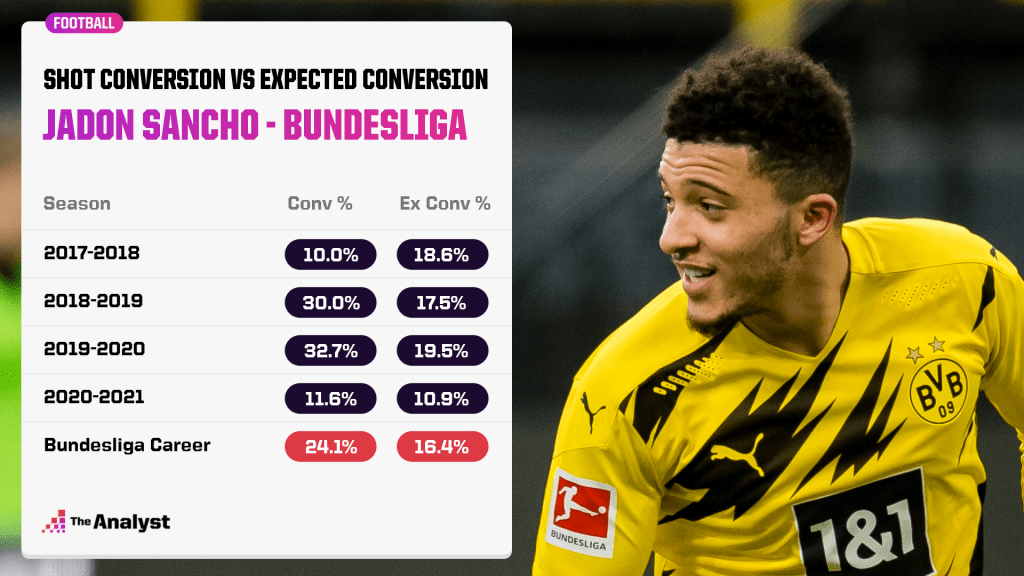
In the final third of the pitch, Sancho is a classic winger. With close control, fantastic agility and frightening pace and acceleration, he is one of the elite wide midfielders in world football, regardless of age. With these key attributes, he uses the full width of the field to regularly set up one-on-one opportunities against full-backs that he can take advantage of.
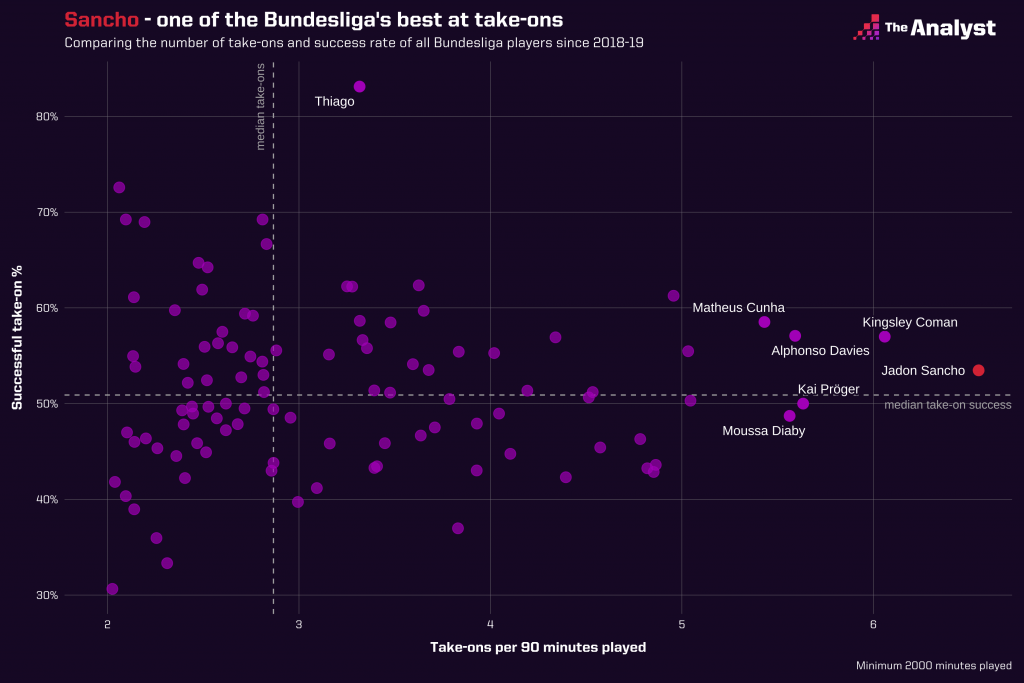
During his time in the Bundesliga, the English forward leads the way in terms of attempted take-ons per 90 with 6.6 and successful take-ons per 90 with 3.5. Since the beginning of the 2018-19 Bundesliga campaign, Sancho has attempted 475 take-ons and completed 254 of those, both figures the most of any player in the league. The Englishman also has a league-high 25 drives into the opposition box across the last three seasons, defined as the number of times a player has carried the ball into the opposition goal area following a successful take-on outside of the box.
When you blend this attacking prowess with his all-round intelligence, you get a player in Sancho that has time and again proven that he can – more single-handedly than most – go and win matches for his side. This is perhaps best exemplified when looking at the chances he creates following a ball carry.
In the Bundesliga this season, the winger has 34 shot involvements following a ball carry (carrying the ball five metres or more), putting him fourth in the league behind Eintracht Frankfurt’s Filip Kostic, Bayer Leverkusen’s Moussa Diaby and Bayern Munich’s Kingsley Coman. However, Sancho is level with Bayern Munich’s Robert Lewandowski for the German top flight’s lead in goal involvements following a carry with nine. Those nine goals not only emphasise his agility and close control but further highlight how clinical he can be in the final third for his side.
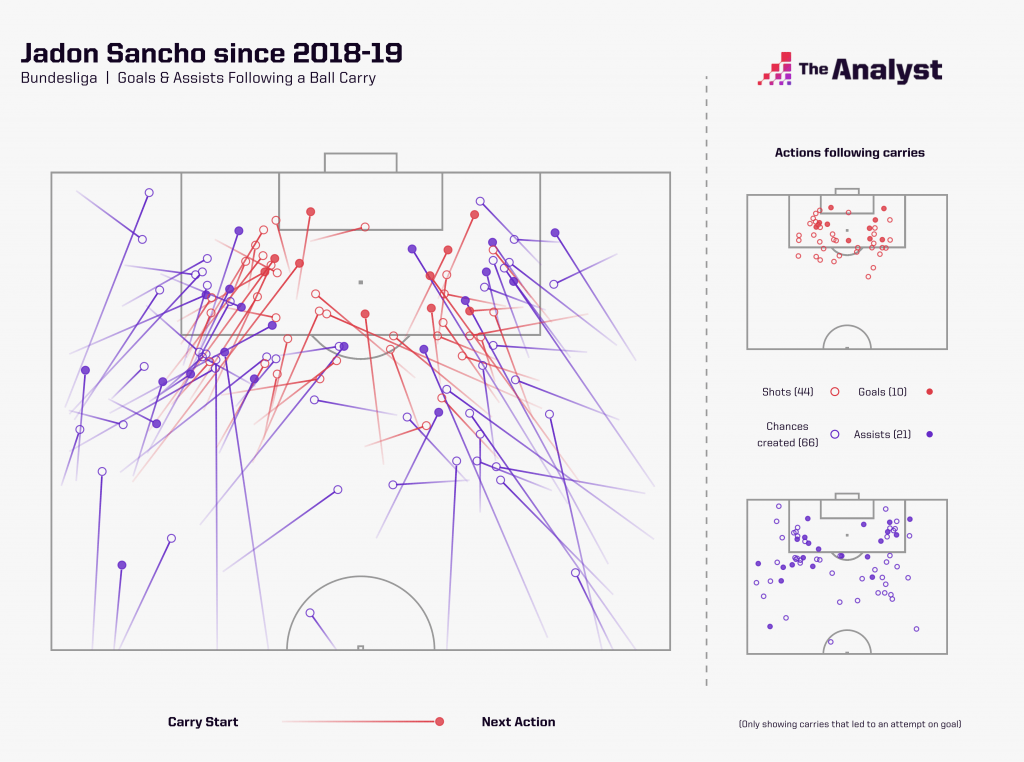
Even more impressive is that he is second only to Barcelona’s Lionel Messi (37) in terms of goal involvements following a ball carry since the 2018-19 season with 31. Since that season, he’s delivered 21 assists following a ball carry tally, which is the best figure in Europe’s top five leagues ahead of Timo Werner (12) and Messi (11).
To put it simply, Sancho’s immense technical ability and vision in the final third means he consistently produces for his club when he gets into great positions on the field.
England fans will be hoping that he can produce that same dazzling form for his country when they take centre stage at this summer’s delayed edition of Euro 2020. If chosen in Gareth Southgate’s final 23-man squad for the tournament, it’ll be the Dortmund winger’s first major international competition with his nation’s senior team. To date, Sancho has appeared 18 times for the 2018 World Cup semi-finalists and has notched three goals and five assists in the process.
With plenty of top-quality wide players to choose from, Southgate certainly has a headache in terms of selecting his best England side at Euro 2020. At present, it would seem that Sancho is perhaps not a first name on his national side’s team sheet, but given his triumph with England at the U17 World Cup just under four years ago, he perhaps understands more than most what it takes to be victorious on the international level. If he continues his fine form in Germany throughout the later stage of the 2020-21 Bundesliga campaign, it’d certainly be surprising to not see him start out wide for the Three Lions this summer.
Now 21, he has already demonstrated that he can be considered as one of football’s finest wide midfielders. With the most goal involvements by an under-21 player since August 2017, from an attacking standpoint there are few players capable of matching his outstanding output on the world stage. With plenty of potential to improve his skillset even further, the English winger could truly develop into his generation’s most impressive talent.
Design by Matt Sisneros.
